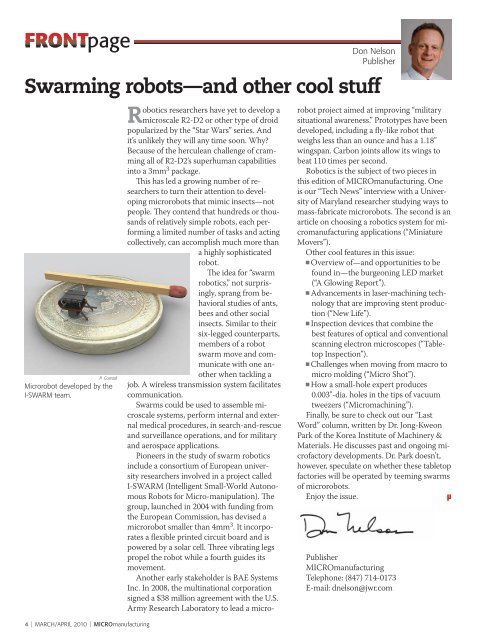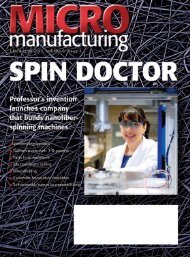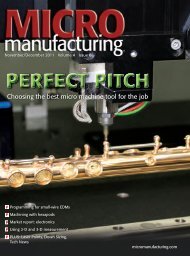Click here to view as PDF - MICROmanufacturing
Click here to view as PDF - MICROmanufacturing
Click here to view as PDF - MICROmanufacturing
Create successful ePaper yourself
Turn your PDF publications into a flip-book with our unique Google optimized e-Paper software.
FRONTpage<br />
Don Nelson<br />
Publisher<br />
Swarming robots—and other cool stuff<br />
P. Corradi<br />
Microrobot developed by the<br />
I-SWARM team.<br />
4 | MARCH/APRIL 2010 | <strong>MICROmanufacturing</strong><br />
Robotics researchers have yet <strong>to</strong> develop a<br />
microscale R2-D2 or other type of droid<br />
popularized by the “Star Wars” series. And<br />
it’s unlikely they will any time soon. Why?<br />
Because of the herculean challenge of cramming<br />
all of R2-D2’s superhuman capabilities<br />
in<strong>to</strong> a 3mm 3 package.<br />
This h<strong>as</strong> led a growing number of researchers<br />
<strong>to</strong> turn their attention <strong>to</strong> developing<br />
microrobots that mimic insects—not<br />
people. They contend that hundreds or thousands<br />
of relatively simple robots, each performing<br />
a limited number of t<strong>as</strong>ks and acting<br />
collectively, can accomplish much more than<br />
a highly sophisticated<br />
robot.<br />
The idea for “swarm<br />
robotics,” not surprisingly,<br />
sprang from behavioral<br />
studies of ants,<br />
bees and other social<br />
insects. Similar <strong>to</strong> their<br />
six-legged counterparts,<br />
members of a robot<br />
swarm move and communicate<br />
with one another<br />
when tackling a<br />
job. A wireless transmission system facilitates<br />
communication.<br />
Swarms could be used <strong>to</strong> <strong>as</strong>semble microscale<br />
systems, perform internal and external<br />
medical procedures, in search-and-rescue<br />
and surveillance operations, and for military<br />
and aerospace applications.<br />
Pioneers in the study of swarm robotics<br />
include a consortium of European university<br />
researchers involved in a project called<br />
I-SWARM (Intelligent Small-World Au<strong>to</strong>nomous<br />
Robots for Micro-manipulation). The<br />
group, launched in 2004 with funding from<br />
the European Commission, h<strong>as</strong> devised a<br />
microrobot smaller than 4mm 3 . It incorporates<br />
a flexible printed circuit board and is<br />
powered by a solar cell. Three vibrating legs<br />
propel the robot while a fourth guides its<br />
movement.<br />
Another early stakeholder is BAE Systems<br />
Inc. In 2008, the multinational corporation<br />
signed a $38 million agreement with the U.S.<br />
Army Research Labora<strong>to</strong>ry <strong>to</strong> lead a microrobot<br />
project aimed at improving “military<br />
situational awareness.” Pro<strong>to</strong>types have been<br />
developed, including a fly-like robot that<br />
weighs less than an ounce and h<strong>as</strong> a 1.18"<br />
wingspan. Carbon joints allow its wings <strong>to</strong><br />
beat 110 times per second.<br />
Robotics is the subject of two pieces in<br />
this edition of <strong>MICROmanufacturing</strong>. One<br />
is our “Tech News” inter<strong>view</strong> with a University<br />
of Maryland researcher studying ways <strong>to</strong><br />
m<strong>as</strong>s-fabricate microrobots. The second is an<br />
article on choosing a robotics system for micromanufacturing<br />
applications (“Miniature<br />
Movers”).<br />
Other cool features in this issue:<br />
■ Over<strong>view</strong> of—and opportunities <strong>to</strong> be<br />
found in—the burgeoning LED market<br />
(“A Glowing Report”).<br />
■ Advancements in l<strong>as</strong>er-machining technology<br />
that are improving stent production<br />
(“New Life”).<br />
■ Inspection devices that combine the<br />
best features of optical and conventional<br />
scanning electron microscopes (“Table<strong>to</strong>p<br />
Inspection”).<br />
■ Challenges when moving from macro <strong>to</strong><br />
micro molding (“Micro Shot”).<br />
■ How a small-hole expert produces<br />
0.003"-dia. holes in the tips of vacuum<br />
tweezers (“Micromachining”).<br />
Finally, be sure <strong>to</strong> check out our “L<strong>as</strong>t<br />
Word” column, written by Dr. Jong-Kweon<br />
Park of the Korea Institute of Machinery &<br />
Materials. He discusses p<strong>as</strong>t and ongoing microfac<strong>to</strong>ry<br />
developments. Dr. Park doesn’t,<br />
however, speculate on whether these table<strong>to</strong>p<br />
fac<strong>to</strong>ries will be operated by teeming swarms<br />
of microrobots.<br />
Enjoy the issue. µ<br />
Publisher<br />
<strong>MICROmanufacturing</strong><br />
Telephone: (847) 714-0173<br />
E-mail: dnelson@jwr.com















